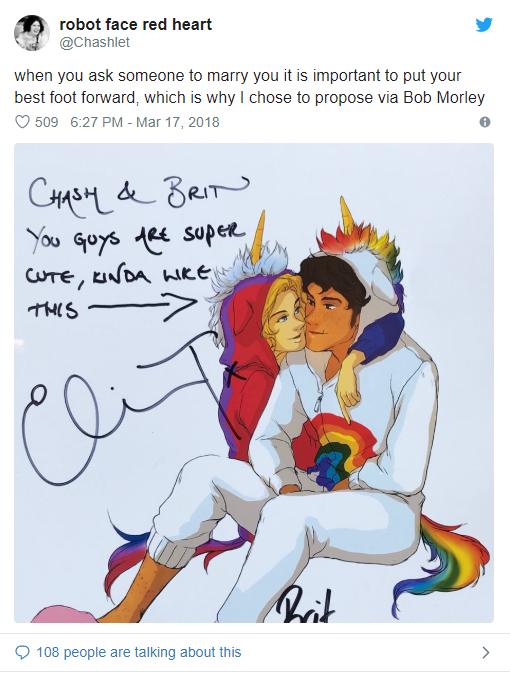Like members of any niche community, fanfic readers often find they have more in common with each other than with outsiders. There is a stigma about discussing fanfic IRL, so if you date someone who’s already in fandom, you no longer have to worry about shutting part of yourself away.
Fandom provides a creative space where people can be open about their passions. A queer community where people explore their identities through art and fiction. A place where it’s normal to have daily, in-depth conversations about love and relationships with people you’ve never met. And while the stereotypical fanfic writer is a young (presumed straight) woman in her teens or twenties, the reality is much more diverse.
In its current form, fanfic culture has been around for decades and is now comfortably into its second or third generation—in some cases literally, since there are plenty of middle-aged couples who originally met on Livejournal or email lists. To shine a light on those love stories, urgent tales of human connection in the disparate internet age, we interviewed a series of couples about how they got together: Women who discovered their sexuality through a shared love of One Direction, a Torchwood fan who used Livejournal as an outlet while she was in a mental hospital, a couple who traversed international borders and immigration law to be together, and more.

One Direction fandom is vast and diverse. You’ve got pop music fans, overlapping with teen stans on Twitter and Tumblr. You’ve got your shippers, who write fanfiction about the band members and occasionally veer into conspiracy theories about their real-life relationships. Then there are the academic types who get seriously analytical about the band’s public image.
Clare and Ellie belong to that last category, stumbling across each other on a private Slack channel aimed at adult fans of the band. They started talking privately after reading the same novel, and soon they were sending each other long emails.
“In these first few weeks I felt really connected and drawn to her,“ said Clare. “She was clearly so smart, and such a good writer, and she was articulating really nuanced ideas about fandom and celebrity in ways I’d never heard anyone talk about.“ They were both fascinated by Harry Styles, sharing “complicated feelings about his public persona and the ways we found him attractive/interesting/aspirational.“
For both women, fandom was key to their sexual awakening. When Clare was still in high school, fandom offered a chance to write queer stories and interact with other queer people, something she couldn’t access in real life. She tells the Daily Dot that this exposure “normalized” her own sexuality.
“The friends I’ve made through [One Direction fandom] are 99% queer, and they’ve been a really great source of support for me. I haven’t gotten super involved in IRL queer spaces for a variety of reasons, and a lot of my closest friends are straight, so it feels really good to have a community in other parts of my life where being queer is almost a given,” she says.
This clashes with the image of boyband fandom being the home of straight girls crushing on unattainable idols. However, it’s backed up by statistical evidence about fanfic and shipping communities as a whole. A recent survey of 17,000 fans showed that straight people were in the minority: 43% of respondents were bi- or pansexual, followed by 29% identifying as somewhere on the asexual spectrum, and 23% as queer. Straights only made up about 20% of the total. Trans people also seem drawn to fandom, with 21% of respondents identifying as nonbinary, and 9% as transgender—a much higher proportion than you see in polls of the general population.
READ MORE:
- Millennials can’t stop writing fanfiction about coffee shops
- Text-message fanfiction is taking over Instagram
- The epic history of ‘shipping’ in fanfiction
So yes, even when your version of fandom involves talking about boybands with other women, it can still be a refuge from the heteronormative expectations of real life. In Ellie’s case, that made Styles a key point in her journey of self-discovery.
“Clare and I joined the Slack in practically the same week, in the summer of 2017. In her intro post, the first thing she mentioned after her name and age was that she was queer. At that point, I wasn’t out even to myself, and I remember that registering with me as something slightly awe-inspiring—the fact that she was so comfortable in how she identified to declare it so casually right off the bat,” Ellie says. “The comfort, security, and happiness I’d felt talking to her online extended to meeting her IRL. The thing about Clare is she makes you want to open up to her. By the time we met for the first time, she knew things about me I’d never told anyone else. A week later, back WhatsApping from our respective countries, she became the first person I came out to.”
Styles occupies a unique place in the celebrity landscape: an A-list heartthrob with progressive politics who visibly rebels against gender roles and has the mystique of a 1940s movie star. He’s a longstanding ally with a seemingly genuine understanding and appreciation for queer culture—which explains why he got to host the Camp-themed Met Gala this year. He’s a perfect illustration of how celebrity crushes aren’t always simple, and how they can actually be a form of self-expression. For Clare and Ellie, part of the attraction was his ambiguous image and the fact that his fandom attracted so many queer women.
“My coming-out process is so directly tied to my experiences in the [One Direction] fandom that it’s difficult to separate the two out,” says Ellie. “Because I hadn’t fully landed on a specific term beyond ‘queer’ yet, I wasn’t ready to start coming out to IRL friends or family. But when my friendship with Clare started to become something more, I was able to start having conversations with people close to me about how I identified. Now I’m out to all my friends and immediate family. That’s something that never would have occurred so quickly (maybe even at all? Who knows!) if I hadn’t found this fandom.”
Skuld discovered the manga series One Piece in 2003, a time when English-language manga fandom was more labor-intensive. Overseas fans relied on fanmade translations of bootlegged Japanese comics, and since Skuld studied Japanese in college, they wound up posting weekly summaries of new One Piece chapters on Livejournal. Meanwhile, their future wife Naye was doing something similar in Japan. Skuld found her while searching for blog posts about a tantalizingly inaccessible Japanese convention, kickstarting a love story that would span nine years and three continents.
After befriending each other online, Naye and Skuld met for the first time in 2010, when Skuld was visiting Osaka. They sang the anime’s opening songs at karaoke.
“That was the summer that season 1 of Sherlock aired, and it totally blew me away. I got Naye into it too, and we started fanning over it together. Over the courses of fanning Sherlock, and writing a lot of fanfiction together, our mutual crush developed into deeper feelings. It took a while, but eventually, we decided to start a long-distance relationship,” Skuld tells the Daily Dot.
Writing or Skyping every day, they stuck it out while Skuld finished their Ph.D. in the U.S. and Naye moved from Japan to Sweden. But as any long-distance couple can tell you, the course of true love can’t run smoothly when immigration law is getting in the way. Naye was able to stay with Skuld for three months on a tourist visa, but same-sex marriage wasn’t legal in the U.S. yet. Naye couldn’t legally stay in the country.
“Because we’re a gay couple, our only choice was to go to Europe. We chose the U.K. because it would be easy for both of us to communicate in English, and Naye, being an EU citizen, could freely live and work in any other EU country. I managed to land a position as a post-doctoral researcher at a prestigious university in the U.K., and finally in the fall of 2012, we both landed at Heathrow at around the same time, to start our new life together,” Skuld says.
They moved in together and Naye proposed a few months later, with the couple arranging a pair of weddings in Europe and the U.S. But after five years in the U.K., the changing political tides made them move.
“Brexit made us feel unwanted, and going back to the U.S. wasn’t an option anymore because it had just elected Donald Trump as president,” Skuld says.
It was time to move again, this time to Scandinavia, where they now live with two cats. After meeting through One Piece, they’ve now moved on to separate fandoms—although they still help with each other’s fanfiction.
At the risk of making anyone feel old, Tracy and Haley’s courtship now feels like a relic of a bygone era. Both obsessed with the X-Files, they met on Livejournal, a platform that functioned very differently from the dominant forces of Tumblr and Twitter today. While Tumblr is notorious for epic controversies caused by viral misunderstandings between strangers (often thanks to the site’s lack of commenting functions), Livejournal is a combination of blogging platform and messageboard, where people could have threaded conversations with a curated list of friends.
“It allowed me to filter and form a tight-knit community to share personal information with, but also publicly share my fic with the fandom as a whole,” Haley told the Daily Dot. “[Livejournal] allowed for more in-depth friendships and relationships to form; it required more time and attention than social media today does.“
READ MORE:
- Man loses it when he realizes he’s reading pervy fanfiction instead of ‘Harry Potter’
- Some of the best writing about the 2016 election was fanfiction
- Does ‘Swamp Thing’ cancellation point to bigger issues with DC Universe?
Tracy was a longtime X-Files fan while Haley was a late adopter, watching the show during her lunch breaks because it was too scary to marathon at night. She’d read some of Tracy’s fanfiction, and after chatting on Livejournal they decided to meet up at San Francisco Pride. The only obstacle was that Haley already had a long-distance girlfriend—another woman in X-Files fandom. It was an impressively non-acrimonious love triangle, with Haley admitting, “My then-girlfriend and Tracy even had a flirtation going on online.
“I walked into the restaurant in Berkeley and saw Tracy and it was all over for me—love at first sight and all that sappy stuff,” Haley continues. “The [girlfriend] and I only lasted another week or two before we broke up, and I don’t think I even waited an hour before I texted Tracy. She was going to a concert in San Francisco and I lied about knowing the artist and bought some tickets off Craigslist. I was too chickenshit to kiss her at the concert, but we hung out at SF Pride as planned and have been together ever since.”
As far as Tracy was concerned, Haley was taken, “so I didn’t really entertain any flirtatious feelings toward either of them after that first meeting.” But when Haley texted her, she was delighted. “I remember the shift in my feelings at that concert and how excited I was to go to Pride with her. The rest is history, as they say, and though I didn’t have the ‘love at first sight’ experience, I knew pretty quick that she was the one for me.”
She was right. Nine years on, they’re now married with two kids. Fandom brought them together, and as their interests moved on, their relationship stayed strong. Their trajectory is an interesting look at how a person’s relationship with fandom can evolve along with their life. Tracy is too busy for fanfic these days, although she’s still in touch with several friends from the X-Files and Battlestar: Galactica message boards. Haley, meanwhile, has since moved on to Sherlock Holmes fandom and organizes a long-running Sherlock gift exchange.
“We met because we were following each other’s Torchwood roleplaying journals. And then he, with the help of Livejournal, saved my life. Literally,” Spider tells the Daily Dot.
During the height of Torchwood fandom, Spider was a member of a roleplaying community called Ask Captain Jack—a precursor to the popular subgenre of Tumblr blogs where people send questions to other fans roleplaying as fictional characters.
“An RP, or role play, was a bunch of people who made a community of journals for fictional characters and interacted with each other in character,” she explains. “RPs were improvised and spontaneous but had varying degrees of organization. They could go on for years; readers followed them like soap operas.”
Spider roleplayed as the Doctor Who character Martha Jones—and so did her future boyfriend, although she didn’t know it at the time. They met through very different circumstances after Spider attempted suicide and ended up in a psychiatric hospital.
“I was really out of it; they were medicating me stupid to the point where I didn’t even think of asking where I was. We weren’t allowed computers or phones because nobody wants cameras on a psych ward. But back then you could post by phone on [Livejournal], so I did that every day from a pay phone. [Livejournal] isn’t like Tumblr, remember; it’s a real journal where you can post real entries and get real conversations with people, so I rambled on the phone in a semi-drugged daze and my friends-list would transcribe my posts and I could feel like I was connected to the world. One day I was rambling that for the first time I was being allowed visitors, but I didn’t know where I was and it was a weekday so nobody could visit me.
I forget how I was able to read replies (my memories of that time are really spotty, as you can imagine) but I got a reply from him. The reply said he knew where I was from the description, and would I like a visit from a trans boy I’d never met? I was like, sure! So he visited me, and we talked a lot about fandom and fandom friends we had in common.
When I got out, he called to ask me if I wanted to go on a date, then another, then another. He gave me support and something to look forward to. We’re celebrating our 10th anniversary this year.“
When we talk about “fan culture,” we don’t just mean the shared feeling of people enjoying the same hobby. Fanfic communities have their own internal rules and social mores, and sometimes outsiders just can’t understand the nuance. In Chash and Brit’s case, they bonded over the complicated experience of being bisexual women in The 100 fandom, where the sexuality of the show’s main character is a hot-button issue.
Brit originally found Chash after reading her Tamora Pierce fanfic and was excited to find out she was into The 100 too. They followed each other on Tumblr, and in Brit’s words, “She was definitely my author crush, and then she became my real crush after we started talking more.”
As the couple tells the Daily Dot in a joint email: “It’s nice to date someone who already knows and understands fan stuff … We had a lot of conversations, both before and after we started dating, that we couldn’t have had with someone who wasn’t in fandom, and even with someone who had different fandom values.”
The 100 fandom is home to an intense ship war, centering around the show’s protagonist Clarke, who is bisexual. At one point Clarke had a girlfriend called Lexa, but many fans also ship Clarke with a male character called Bellamy. The rivalry between Bellarke and Clexa fans ties into a lot of messy politics around bisexual visibility in media, combining the typical controversy of a ship war with some sensitive issues. Chash and Brit are in the automatically (and unfairly) controversial position of being bisexual women who ship Bellarke—the male/female pairing that some fans believe is homophobic.
“There was a lot of bi-erasure surrounding bi fans who liked Bellarke, and before we started dating, we would talk about our anxiety not only about dating queer women who were biphobic, but finding other queer fans who wouldn’t dismiss us for not shipping Clexa. So we really appreciated having that shared experience of being angry about the show’s broad choices in dealing with Lexa, but also feeling alienated and erased by a lot of the fallout,” the shared email says. “The downside of meeting through fandom was that we used to worry that our relationship might not survive our falling out of the fandom, because it was such a big part of how we got to know each other. At this point, we’ve been in a relationship for almost three years, living together for two of those and married for one, so we feel pretty confident that we’re going to be fine. That being said, we’re still hoping we never end up on opposite sides of a ship war.”

Speaking to people who found love through fandom, the idea of shared experience is a recurring theme.
It’s not just that fanfic culture can seem incomprehensible to outsiders, it’s that until recently, most people kept their fannish lives a secret. There’s still a stigma attached to fanfic and shipping, which is often viewed as more frivolous than the male-dominated side of geek culture.
Among the other fans, we spoke to for this article, several mentioned ex-boyfriends or husbands who either openly mocked their hobbies, or made it clear they weren’t interested. Anna, a fanfic writer who met her girlfriend via Dead Poets Society and High School Musical fic, put it simply: “I did always sort of think that fandom was something I’d have to give up, or at least significantly tone down with a significant other.”
There’s a pervasive idea that fandom is something you’ll grow out of once you enter a long-term relationship, tying into the image of women giving up their hobbies once they become wives and mothers. But if you date someone within fandom, that expectation vanishes. Even if your partner isn’t in the same fandom as you, or you move onto different interests, you still understand where the other is coming from—a mindset that goes much deeper than just being a fan of the same thing.
READ MORE:
- ‘I Am Mother’ is a smart, dystopian coming-of-age story
- ‘Men in Black: International’ fails its charismatic stars
- Every ‘X-Men’ movie, ranked from best to worst
Want more reviews and interviews from Gavia Baker-Whitelaw? Sign up here to receive her biweekly geek culture newsletter.






